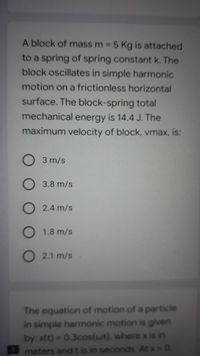Question

Transcribed Image Text:A block of mass m 5 Kg is attached
to a spring of spring constant k. The
block oscillates in simple harmonic
motion on a frictionless horizontal
surface. The block-spring total
mechanical energy is 14.4 J. The
maximum velocity of block, vmax, is:
O 3 m/s
3.8 m/s
O 2.4 m/s
O 1.8 m/s
O 2.1 m/s
The equation of motion of a particle
in simple harmonic motion is given
by: x(t) 0.3cos(wt), where x is in
I meters and t is in seconds At x 0.
Expert Solution
This question has been solved!
Explore an expertly crafted, step-by-step solution for a thorough understanding of key concepts.
Step by stepSolved in 2 steps with 2 images

Knowledge Booster
Similar questions
- I need help with finding the last part. A moving 1.70 kg block collides with a horizontal spring whose spring constant is 303 N/m. The block compresses the spring a maximum distance of 14.50 cm from its rest position. The coefficient of kinetic friction between the block and the horizontal surface is 0.120. What is the work done by the spring in bringing the block to rest? How much mechanical energy is being dissipated by the force of friction while the block is being brought to rest by the spring? What is the speed of the block when it hits the spring?arrow_forwardA mass of 0.25 kg is attached to a spring whose spring constant is k = 25 N/m. The spring is compressed 0.35 m on a frictionless surface and released from rest. At what location is the kinetic energy at a maximum, what is the amount of kinetic energy, and what is the velocity of the mass at that point?arrow_forwardA spring of spring constant k = 12.3 N/m is compressed from it's equilibrium position by 28.1 cm. How much energy is stored in the elastic potential energy of the spring?arrow_forward
arrow_back_ios
arrow_forward_ios